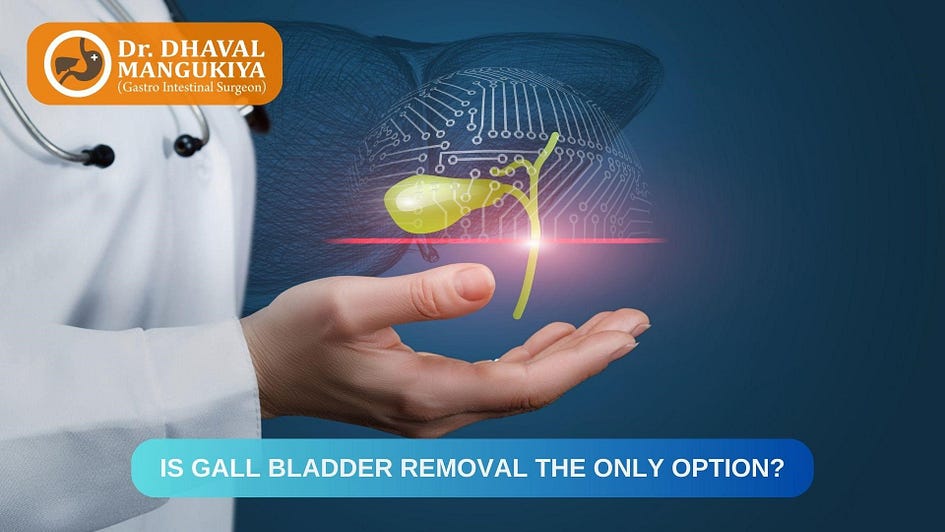Is Gallbladder Removal the Only Option? Know The Answer By The Best Gallbladder Surgeon In Surat

Gallbladder disease is a common but often misunderstood condition that affects millions of people worldwide. While gallbladder removal is a well-known solution, it’s essential to recognize that surgery isn’t the only option. In this blog Dr Dhaval Mangukiya, one of the best gallbladder surgeons in Surat, will explain the intricacies of gallbladder disease, exploring symptoms, complications, and surgical alternatives that go beyond the conventional approach.
Understanding Gallbladder Disease:
The gallbladder, a small organ situated beneath the liver, plays a crucial role in digestion by storing bile produced by the liver. Gallbladder disease encompasses a range of conditions that affect the proper functioning of this organ. The most common among them is cholecystitis, an inflammation of the gallbladder, often associated with the formation of gallstones.
Symptoms and Complications:
Gallbladder disease can manifest in various ways, and its symptoms can range from mild discomfort to severe pain. Individuals with gallbladder issues may experience persistent pain in the upper abdomen, nausea, vomiting, and bloating. Complications can arise when gallstones block the normal flow of bile, leading to inflammation, infection, or even rupture of the gallbladder. Recognizing these symptoms is crucial for consulting the best gastro surgeon in Surat and preventing further complications.
Understanding Gallstones:
Gallstones, small solid particles that form in the gallbladder, are a common culprit in gallbladder disease. They can vary in size and composition, ranging from cholesterol stones to pigment stones. The presence of gallstones can lead to blockages in the bile ducts, causing pain and inflammation. Understanding the nature of gallstones is essential in determining the most suitable course of action for treatment.
Who is Most at Risk for Gallstones?
Certain factors increase the risk of developing gallstones. Some of the best gastrointestinal surgeons in Surat have marked these factors as obesity, rapid weight loss, pregnancy, a sedentary lifestyle, and a family history of gallbladder disease. Women, especially those over the age of 40, are more prone to gallstones than men. Recognizing these risk factors can aid in proactive measures to prevent gallstone formation and associated complications.
When Does a Gallbladder Need to be Removed?
Gallbladder removal, or cholecystectomy, is a common surgical procedure performed when the gallbladder is inflamed or contains gallstones causing persistent symptoms. Dr Dhaval Mangukiya, one of the best laparoscopic surgeons in Surat, says that while surgery is effective in alleviating symptoms and preventing further complications, it’s not always the only solution. In some cases, alternative surgical approaches may be considered, depending on the specific nature of the gallbladder disease and the patient’s overall health.
Exploring Alternative Surgical Options:
For individuals seeking alternatives to complete gallbladder removal, there are minimally invasive surgical options available. Laparoscopic cholecystectomy, a less invasive procedure than traditional open surgery, involves making small incisions and using a tiny camera and special instruments to remove the gallbladder. This approach generally results in a quicker recovery and less scarring.
Another option is gallbladder-preserving surgery, which focuses on removing only the gallstones while leaving the gallbladder intact. This approach is suitable for certain cases where gallstones are the primary issue, and the gallbladder is still functioning well. However, it requires careful patient selection and ongoing monitoring to ensure the effectiveness of the procedure.
What to Expect with Gallbladder Surgery?
Whether opting for gallbladder removal or an alternative surgical approach, it’s essential to understand what to expect during and after the procedure. Gallbladder surgery is typically performed under general anaesthesia, and recovery times vary depending on the surgical technique used. Laparoscopic procedures often allow for a quicker return to normal activities compared to open surgery.
After surgery, patients may experience some discomfort and are advised to follow a special diet temporarily. Dietary adjustments, such as avoiding fatty foods, may be recommended to help the digestive system adapt to the absence of the gallbladder. It’s crucial to adhere to post-operative instructions provided by healthcare professionals for a smooth recovery.
Conclusion:
Gallbladder disease is a complex condition that requires careful consideration of various factors when determining the most appropriate treatment approach. While gallbladder removal is a common solution, alternative surgical options exist for those seeking alternatives. By understanding the symptoms, complications, and surgical choices available, individuals can make informed decisions about their gallbladder health, working towards optimal well-being and a smoother road to recovery.
Comments
Post a Comment